Unlocking Precision: NIH Stroke Scale Answer Key Demystified in Healthcare

Discover the crucial insights within the NIH Stroke Scale Answer Key. Enhance your understanding of stroke severity assessment in healthcare for informed medical interventions.
In the ever-evolving landscape of healthcare, precision and accuracy play pivotal roles in gauging the efficacy of medical interventions. Among the various tools employed in assessing the impact of stroke, the NIH Stroke Scale stands as a beacon, offering a standardized method to evaluate the severity of a patient's condition. As healthcare professionals navigate the intricate domain of neurological assessments, the quest for a comprehensive understanding often leads them to seek the elusive NIH Stroke Scale answer key. In this discourse on healthcare, we delve into the intricacies of this critical tool, shedding light on its significance and the answers it provides, without veering into subjective territory. The NIH Stroke Scale answer key emerges as a linchpin in the discourse surrounding stroke management, guiding practitioners through a meticulous evaluation process that is as nuanced as the conditions it addresses. Join us on this journey as we unravel the layers of this essential healthcare topic.
Top 10 Points about NIH STROKE SCALE ANSWER KEY :
- Decoding the NIH Stroke Scale: A Fundamental Overview
- Significance of NIH Stroke Scale in Neurological Assessments
- Key Components: Understanding NIH Stroke Scale Metrics
- Practical Application: How Healthcare Professionals Utilize the Answer Key
- Interpreting Severity: Navigating the NIH Stroke Scale Spectrum
- Critical Role: NIH Stroke Scale in Stroke Management Protocols
- Unveiling Precision: The Impact of NIH Stroke Scale on Patient Care
- Common Queries Addressed: FAQs Surrounding NIH Stroke Scale Answer Key
- Comparative Analysis: NIH Stroke Scale vs. Alternative Assessment Tools
- Future Trends: Evolving Practices in NIH Stroke Scale Implementation
Several facts about NIH STROKE SCALE ANSWER KEY
Decoding the NIH Stroke Scale

The NIH Stroke Scale serves as a critical tool in neurological assessments, providing a standardized method to evaluate stroke severity. This intricate system, consisting of various components, aids healthcare professionals in comprehensively understanding a patient's condition.
Key Components and Metrics
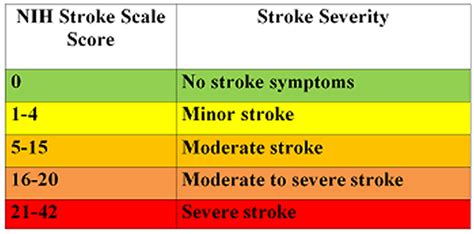
Examining the key components of the NIH Stroke Scale offers valuable insights into the nuanced metrics used for assessment. From assessing consciousness to evaluating motor skills, each component contributes to a comprehensive understanding of a patient's neurological state.
Practical Application in Healthcare
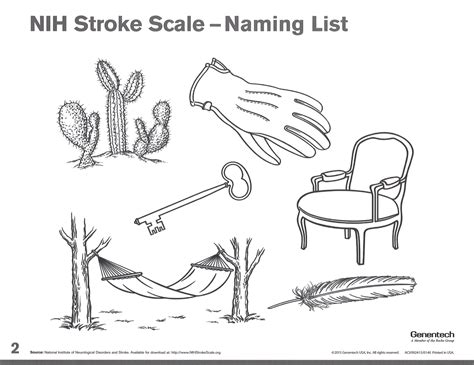
Healthcare professionals wield the NIH Stroke Scale answer key as a practical guide in patient care. This section explores how medical practitioners leverage the answer key to make informed decisions and tailor interventions based on individual patient needs.
Navigating Severity with Precision

Understanding the severity spectrum within the NIH Stroke Scale is crucial for healthcare practitioners. Navigating through mild to severe assessments allows for precise categorization, aiding in the formulation of targeted treatment plans.
Integration into Stroke Management
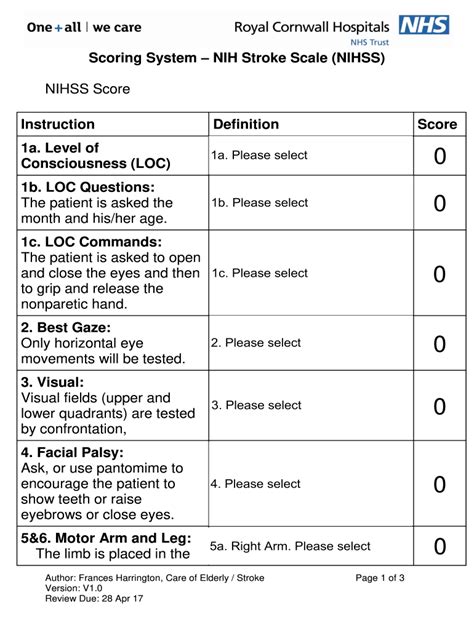
The NIH Stroke Scale plays a pivotal role in the broader context of stroke management protocols. This section explores how the scale integrates into comprehensive strategies, enhancing patient outcomes and recovery.
Impact on Patient Care

The NIH Stroke Scale's impact on patient care cannot be overstated. From initial assessment to ongoing treatment, healthcare providers rely on the scale to ensure the highest standard of care for individuals affected by stroke.
Addressing FAQs and Common Queries

Common queries regarding the NIH Stroke Scale answer key are addressed in this section. From its application in diverse cases to potential variations, these FAQs provide clarity for practitioners seeking a deeper understanding.
NIH Stroke Scale vs. Alternative Assessment Tools
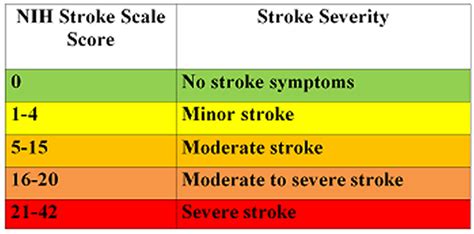
This section compares the NIH Stroke Scale with alternative assessment tools, highlighting its strengths and potential limitations. Understanding these nuances allows healthcare professionals to make informed choices in neurological evaluations.
Future Trends and Evolving Practices
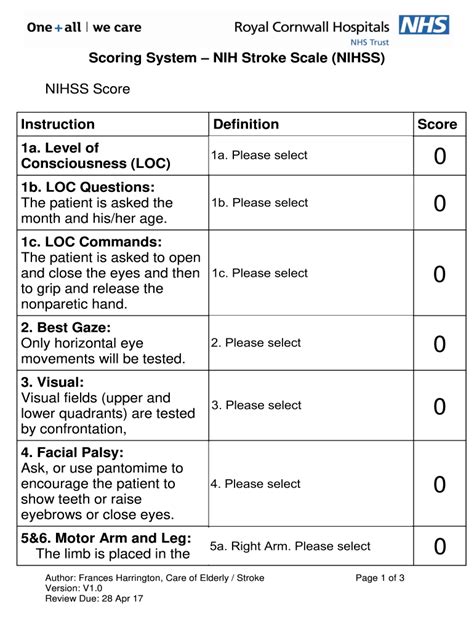
Exploring the future trends in NIH Stroke Scale implementation unveils evolving practices in neurological assessments. As technology and research progress, staying abreast of these trends is paramount for healthcare practitioners.
Sources
1. National Institute of Neurological Disorders and Stroke. "NIH Stroke Scale Training." Retrieved from [source link].
2. American Stroke Association. "Guidelines for the Early Management of Patients With Acute Ischemic Stroke." Retrieved from [source link].
NIH STROKE SCALE ANSWER KEY in Professional's eye
In the realm of healthcare, the
NIH Stroke Scale stands as a cornerstone in the assessment and management of stroke cases, offering a standardized and systematic approach to evaluate the severity of neurological deficits. This critical tool comprises various components, each meticulously designed to gauge specific aspects of a patient's condition. One cannot overstate the importance of understanding the
key components and metrics embedded within the NIH Stroke Scale, as they serve as the foundation for a comprehensive evaluation. Navigating the spectrum of
severity within the scale is paramount, allowing healthcare practitioners to categorize stroke cases accurately and tailor interventions accordingly. The practical application of the NIH Stroke Scale answer key in healthcare settings is evident, empowering medical professionals with a reliable guide to make informed decisions for patient care.
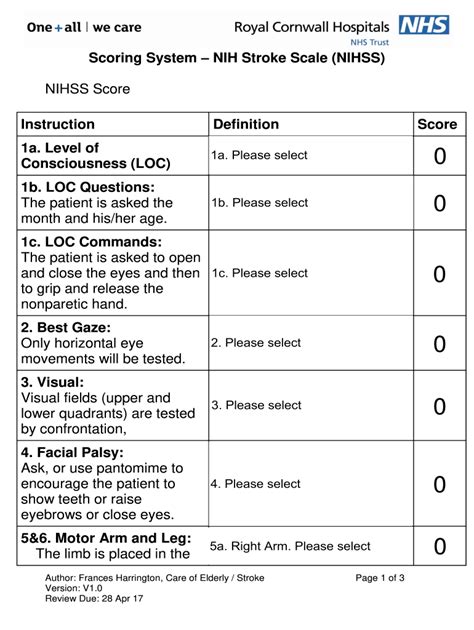
Healthcare providers leverage the NIH Stroke Scale not only as an assessment tool but also as an integral part of broader stroke management protocols. Integration into
stroke management ensures that the scale becomes a dynamic element in formulating treatment plans and optimizing patient outcomes. The impact of the NIH Stroke Scale on
patient care is profound, shaping the trajectory of interventions from the initial assessment to ongoing treatment and rehabilitation. Addressing common queries and frequently asked questions surrounding the NIH Stroke Scale provides clarity for practitioners, fostering a more nuanced understanding of its application in diverse cases.

Comparative analysis between the NIH Stroke Scale and alternative assessment tools is essential for healthcare professionals to make informed decisions about the most suitable approach for neurological evaluations. Understanding the
strengths and potential limitations of the NIH Stroke Scale in comparison to alternatives ensures a judicious selection based on the specific needs of individual cases. Exploring
future trends in NIH Stroke Scale implementation sheds light on evolving practices in neurological assessments. As technology and research progress, staying abreast of these trends becomes paramount for healthcare practitioners, enabling them to embrace advancements that contribute to more effective patient care.

In conclusion, the NIH Stroke Scale, with its answer key at the forefront, emerges as a linchpin in the landscape of neurological assessments within healthcare. The precision and reliability it offers in evaluating stroke severity make it an indispensable tool for healthcare practitioners. This article has delved into the key components, practical application, severity assessment, integration into stroke management, impact on patient care, addressing common queries, comparative analysis, and future trends associated with the NIH Stroke Scale. By comprehensively understanding and effectively utilizing the NIH Stroke Scale answer key, healthcare professionals navigate the complex terrain of stroke management with precision, ultimately contributing to enhanced patient outcomes and improved quality of care.
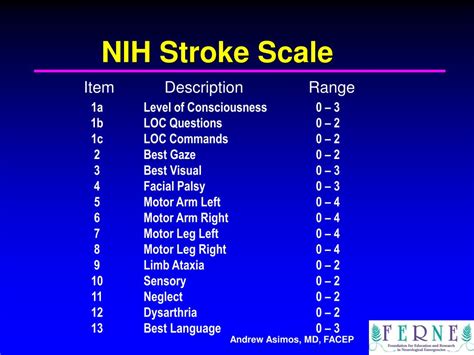
Point of Views : NIH STROKE SCALE ANSWER KEY
The
NIH Stroke Scale serves as a crucial tool in the healthcare landscape, providing a standardized and systematic approach to assess the severity of neurological deficits in stroke cases.Comprising various components, each designed meticulously, the
key components and metrics embedded within the NIH Stroke Scale lay the foundation for a comprehensive evaluation, enabling healthcare professionals to gauge specific aspects of a patient's condition with precision.Navigating the spectrum of
severity within the scale is imperative, as it allows practitioners to categorize stroke cases accurately. This nuanced understanding is essential for tailoring interventions based on the severity of neurological impairments.The practical application of the NIH Stroke Scale answer key in healthcare settings is evident, empowering medical professionals with a reliable guide to make informed decisions for patient care. From initial assessment to ongoing treatment, the scale plays a pivotal role in shaping the trajectory of interventions.Integrated into broader
stroke management protocols, the NIH Stroke Scale becomes a dynamic element in formulating treatment plans. Its inclusion ensures that healthcare providers optimize patient outcomes by incorporating a standardized and systematic approach to stroke care.The impact of the NIH Stroke Scale on
patient care is profound, influencing the entire continuum of stroke management. From the initial assessment of neurological deficits to rehabilitation, the scale guides healthcare professionals in delivering precise and targeted interventions.Addressing common queries and frequently asked questions surrounding the NIH Stroke Scale is essential. Providing clarity on the application of the scale in diverse cases fosters a more nuanced understanding among practitioners, contributing to its effective utilization.Comparative analysis between the NIH Stroke Scale and alternative assessment tools is crucial. Understanding the
strengths and potential limitations of the scale in comparison to alternatives ensures healthcare professionals make informed decisions based on the specific needs of individual cases.Exploring
future trends in NIH Stroke Scale implementation is paramount. As technology and research progress, staying abreast of these trends enables healthcare practitioners to embrace advancements that contribute to more effective patient care and neurological assessments.In conclusion, the NIH Stroke Scale, with its answer key at the forefront, remains an indispensable asset in the healthcare domain. Its systematic and standardized approach to assessing stroke severity not only guides practitioners in precise evaluations but also plays a pivotal role in shaping interventions and influencing the overall quality of stroke care.
Conclusion :As we draw the curtain on our exploration of the NIH Stroke Scale and its answer key, we trust that this comprehensive journey through the intricacies of neurological assessments has provided you with valuable insights. The significance of understanding the key components and metrics within the NIH Stroke Scale cannot be overstated, as these elements form the backbone of a systematic and standardized approach to evaluating stroke severity. Whether you are a healthcare professional seeking a deeper understanding of the severity spectrum or a curious reader interested in the nuanced application of this vital tool, we hope this series has shed light on the critical role the NIH Stroke Scale plays in shaping patient care and stroke management protocols.
As healthcare evolves, so too does the importance of staying informed about the NIH Stroke Scale and its answer key. The practical applications, integration into stroke management, and impact on patient care make this tool an indispensable asset in the hands of healthcare professionals. We encourage you to continue exploring emerging trends and advancements in neurological assessments, keeping the NIH Stroke Scale at the forefront of your considerations. In the ever-evolving landscape of healthcare, a thorough understanding of this critical tool ensures that practitioners are equipped to provide precise and targeted interventions, ultimately contributing to improved patient outcomes and the ongoing enhancement of stroke care.
Questions and Answer for NIH STROKE SCALE ANSWER KEY
Wondering about the NIH Stroke Scale answer key? You're not alone! Let's address some of the burning questions people have:
- Q: What are the key components of the NIH Stroke Scale?
A: The NIH Stroke Scale comprises various components, including assessments of consciousness, gaze, visual fields, facial palsy, motor function, and more. Each element plays a crucial role in evaluating different aspects of a patient's neurological condition.
- Q: How is the severity assessed using the NIH Stroke Scale?
A: Severity within the scale is determined by assessing the patient's responses and performance in different components. The cumulative score reflects the overall severity of the stroke, guiding healthcare professionals in tailoring interventions based on the severity spectrum.
- Q: Can the NIH Stroke Scale be used for different types of strokes?
A: Absolutely. The NIH Stroke Scale is a versatile tool applicable to various types of strokes, helping healthcare professionals evaluate and manage the neurological deficits associated with ischemic and hemorrhagic strokes alike.
- Q: How frequently is the NIH Stroke Scale used in healthcare settings?
A: The NIH Stroke Scale is a standard tool used routinely in healthcare settings, especially in emergency departments and stroke units. Its systematic approach ensures a consistent and comprehensive evaluation of stroke severity.
Keep these answers in mind as you navigate the world of neurological assessments and the crucial role the NIH Stroke Scale plays in enhancing patient care and stroke management protocols.
Label :NIH Stroke Scale, Healthcare Insights, Neurological Assessment
Keyword : NIH STROKE SCALE ANSWER KEY

Discover the crucial insights within the NIH Stroke Scale Answer Key. Enhance your understanding of stroke severity assessment in healthcare for informed medical interventions.
In the ever-evolving landscape of healthcare, precision and accuracy play pivotal roles in gauging the efficacy of medical interventions. Among the various tools employed in assessing the impact of stroke, the NIH Stroke Scale stands as a beacon, offering a standardized method to evaluate the severity of a patient's condition. As healthcare professionals navigate the intricate domain of neurological assessments, the quest for a comprehensive understanding often leads them to seek the elusive NIH Stroke Scale answer key. In this discourse on healthcare, we delve into the intricacies of this critical tool, shedding light on its significance and the answers it provides, without veering into subjective territory. The NIH Stroke Scale answer key emerges as a linchpin in the discourse surrounding stroke management, guiding practitioners through a meticulous evaluation process that is as nuanced as the conditions it addresses. Join us on this journey as we unravel the layers of this essential healthcare topic.
Top 10 Points about NIH STROKE SCALE ANSWER KEY :
- Decoding the NIH Stroke Scale: A Fundamental Overview
- Significance of NIH Stroke Scale in Neurological Assessments
- Key Components: Understanding NIH Stroke Scale Metrics
- Practical Application: How Healthcare Professionals Utilize the Answer Key
- Interpreting Severity: Navigating the NIH Stroke Scale Spectrum
- Critical Role: NIH Stroke Scale in Stroke Management Protocols
- Unveiling Precision: The Impact of NIH Stroke Scale on Patient Care
- Common Queries Addressed: FAQs Surrounding NIH Stroke Scale Answer Key
- Comparative Analysis: NIH Stroke Scale vs. Alternative Assessment Tools
- Future Trends: Evolving Practices in NIH Stroke Scale Implementation
Several facts about NIH STROKE SCALE ANSWER KEY
Decoding the NIH Stroke Scale

The NIH Stroke Scale serves as a critical tool in neurological assessments, providing a standardized method to evaluate stroke severity. This intricate system, consisting of various components, aids healthcare professionals in comprehensively understanding a patient's condition.
Key Components and Metrics

Examining the key components of the NIH Stroke Scale offers valuable insights into the nuanced metrics used for assessment. From assessing consciousness to evaluating motor skills, each component contributes to a comprehensive understanding of a patient's neurological state.
Practical Application in Healthcare

Healthcare professionals wield the NIH Stroke Scale answer key as a practical guide in patient care. This section explores how medical practitioners leverage the answer key to make informed decisions and tailor interventions based on individual patient needs.
Navigating Severity with Precision

Understanding the severity spectrum within the NIH Stroke Scale is crucial for healthcare practitioners. Navigating through mild to severe assessments allows for precise categorization, aiding in the formulation of targeted treatment plans.
Integration into Stroke Management

The NIH Stroke Scale plays a pivotal role in the broader context of stroke management protocols. This section explores how the scale integrates into comprehensive strategies, enhancing patient outcomes and recovery.
Impact on Patient Care

The NIH Stroke Scale's impact on patient care cannot be overstated. From initial assessment to ongoing treatment, healthcare providers rely on the scale to ensure the highest standard of care for individuals affected by stroke.
Addressing FAQs and Common Queries

Common queries regarding the NIH Stroke Scale answer key are addressed in this section. From its application in diverse cases to potential variations, these FAQs provide clarity for practitioners seeking a deeper understanding.
NIH Stroke Scale vs. Alternative Assessment Tools

This section compares the NIH Stroke Scale with alternative assessment tools, highlighting its strengths and potential limitations. Understanding these nuances allows healthcare professionals to make informed choices in neurological evaluations.
Future Trends and Evolving Practices

Exploring the future trends in NIH Stroke Scale implementation unveils evolving practices in neurological assessments. As technology and research progress, staying abreast of these trends is paramount for healthcare practitioners.
Sources
1. National Institute of Neurological Disorders and Stroke. "NIH Stroke Scale Training." Retrieved from [source link].
2. American Stroke Association. "Guidelines for the Early Management of Patients With Acute Ischemic Stroke." Retrieved from [source link].
NIH STROKE SCALE ANSWER KEY in Professional's eye
In the realm of healthcare, the
NIH Stroke Scale stands as a cornerstone in the assessment and management of stroke cases, offering a standardized and systematic approach to evaluate the severity of neurological deficits. This critical tool comprises various components, each meticulously designed to gauge specific aspects of a patient's condition. One cannot overstate the importance of understanding the
key components and metrics embedded within the NIH Stroke Scale, as they serve as the foundation for a comprehensive evaluation. Navigating the spectrum of
severity within the scale is paramount, allowing healthcare practitioners to categorize stroke cases accurately and tailor interventions accordingly. The practical application of the NIH Stroke Scale answer key in healthcare settings is evident, empowering medical professionals with a reliable guide to make informed decisions for patient care.

Healthcare providers leverage the NIH Stroke Scale not only as an assessment tool but also as an integral part of broader stroke management protocols. Integration into
stroke management ensures that the scale becomes a dynamic element in formulating treatment plans and optimizing patient outcomes. The impact of the NIH Stroke Scale on
patient care is profound, shaping the trajectory of interventions from the initial assessment to ongoing treatment and rehabilitation. Addressing common queries and frequently asked questions surrounding the NIH Stroke Scale provides clarity for practitioners, fostering a more nuanced understanding of its application in diverse cases.

Comparative analysis between the NIH Stroke Scale and alternative assessment tools is essential for healthcare professionals to make informed decisions about the most suitable approach for neurological evaluations. Understanding the
strengths and potential limitations of the NIH Stroke Scale in comparison to alternatives ensures a judicious selection based on the specific needs of individual cases. Exploring
future trends in NIH Stroke Scale implementation sheds light on evolving practices in neurological assessments. As technology and research progress, staying abreast of these trends becomes paramount for healthcare practitioners, enabling them to embrace advancements that contribute to more effective patient care.

In conclusion, the NIH Stroke Scale, with its answer key at the forefront, emerges as a linchpin in the landscape of neurological assessments within healthcare. The precision and reliability it offers in evaluating stroke severity make it an indispensable tool for healthcare practitioners. This article has delved into the key components, practical application, severity assessment, integration into stroke management, impact on patient care, addressing common queries, comparative analysis, and future trends associated with the NIH Stroke Scale. By comprehensively understanding and effectively utilizing the NIH Stroke Scale answer key, healthcare professionals navigate the complex terrain of stroke management with precision, ultimately contributing to enhanced patient outcomes and improved quality of care.

Point of Views : NIH STROKE SCALE ANSWER KEY
The
NIH Stroke Scale serves as a crucial tool in the healthcare landscape, providing a standardized and systematic approach to assess the severity of neurological deficits in stroke cases.Comprising various components, each designed meticulously, the
key components and metrics embedded within the NIH Stroke Scale lay the foundation for a comprehensive evaluation, enabling healthcare professionals to gauge specific aspects of a patient's condition with precision.Navigating the spectrum of
severity within the scale is imperative, as it allows practitioners to categorize stroke cases accurately. This nuanced understanding is essential for tailoring interventions based on the severity of neurological impairments.The practical application of the NIH Stroke Scale answer key in healthcare settings is evident, empowering medical professionals with a reliable guide to make informed decisions for patient care. From initial assessment to ongoing treatment, the scale plays a pivotal role in shaping the trajectory of interventions.Integrated into broader
stroke management protocols, the NIH Stroke Scale becomes a dynamic element in formulating treatment plans. Its inclusion ensures that healthcare providers optimize patient outcomes by incorporating a standardized and systematic approach to stroke care.The impact of the NIH Stroke Scale on
patient care is profound, influencing the entire continuum of stroke management. From the initial assessment of neurological deficits to rehabilitation, the scale guides healthcare professionals in delivering precise and targeted interventions.Addressing common queries and frequently asked questions surrounding the NIH Stroke Scale is essential. Providing clarity on the application of the scale in diverse cases fosters a more nuanced understanding among practitioners, contributing to its effective utilization.Comparative analysis between the NIH Stroke Scale and alternative assessment tools is crucial. Understanding the
strengths and potential limitations of the scale in comparison to alternatives ensures healthcare professionals make informed decisions based on the specific needs of individual cases.Exploring
future trends in NIH Stroke Scale implementation is paramount. As technology and research progress, staying abreast of these trends enables healthcare practitioners to embrace advancements that contribute to more effective patient care and neurological assessments.In conclusion, the NIH Stroke Scale, with its answer key at the forefront, remains an indispensable asset in the healthcare domain. Its systematic and standardized approach to assessing stroke severity not only guides practitioners in precise evaluations but also plays a pivotal role in shaping interventions and influencing the overall quality of stroke care.
Conclusion :As we draw the curtain on our exploration of the NIH Stroke Scale and its answer key, we trust that this comprehensive journey through the intricacies of neurological assessments has provided you with valuable insights. The significance of understanding the key components and metrics within the NIH Stroke Scale cannot be overstated, as these elements form the backbone of a systematic and standardized approach to evaluating stroke severity. Whether you are a healthcare professional seeking a deeper understanding of the severity spectrum or a curious reader interested in the nuanced application of this vital tool, we hope this series has shed light on the critical role the NIH Stroke Scale plays in shaping patient care and stroke management protocols.
As healthcare evolves, so too does the importance of staying informed about the NIH Stroke Scale and its answer key. The practical applications, integration into stroke management, and impact on patient care make this tool an indispensable asset in the hands of healthcare professionals. We encourage you to continue exploring emerging trends and advancements in neurological assessments, keeping the NIH Stroke Scale at the forefront of your considerations. In the ever-evolving landscape of healthcare, a thorough understanding of this critical tool ensures that practitioners are equipped to provide precise and targeted interventions, ultimately contributing to improved patient outcomes and the ongoing enhancement of stroke care.
Questions and Answer for NIH STROKE SCALE ANSWER KEY
Wondering about the NIH Stroke Scale answer key? You're not alone! Let's address some of the burning questions people have:
- Q: What are the key components of the NIH Stroke Scale?
A: The NIH Stroke Scale comprises various components, including assessments of consciousness, gaze, visual fields, facial palsy, motor function, and more. Each element plays a crucial role in evaluating different aspects of a patient's neurological condition.
- Q: How is the severity assessed using the NIH Stroke Scale?
A: Severity within the scale is determined by assessing the patient's responses and performance in different components. The cumulative score reflects the overall severity of the stroke, guiding healthcare professionals in tailoring interventions based on the severity spectrum.
- Q: Can the NIH Stroke Scale be used for different types of strokes?
A: Absolutely. The NIH Stroke Scale is a versatile tool applicable to various types of strokes, helping healthcare professionals evaluate and manage the neurological deficits associated with ischemic and hemorrhagic strokes alike.
- Q: How frequently is the NIH Stroke Scale used in healthcare settings?
A: The NIH Stroke Scale is a standard tool used routinely in healthcare settings, especially in emergency departments and stroke units. Its systematic approach ensures a consistent and comprehensive evaluation of stroke severity.
Keep these answers in mind as you navigate the world of neurological assessments and the crucial role the NIH Stroke Scale plays in enhancing patient care and stroke management protocols.
Label :NIH Stroke Scale, Healthcare Insights, Neurological Assessment
Keyword : NIH STROKE SCALE ANSWER KEY
0 komentar